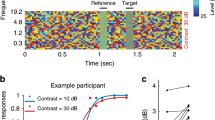Abstract
A nonlinear function is derived to describe the contrast transduction process for human visual mechanisms. This function is sigmoid in form, having an accelerating nonlinearity at low contrasts and a compressive nonlinearity at high contrasts. The resulting formulation is consistent with both signal detection theory and with Quick's (1974) equation for probability summation. Similarities between the present description of human vision and properties of complex cells in cat visual cortex are noted.
Similar content being viewed by others
References
Bergen, J.B., Wilson, H.R., Cowan, J.D.: Further evidence for four mechanisms mediating vision at threshold: sensitivities to complex gratings and aperiodic stimuli. J. Opt. Soc. Am. 69, 1580–1587 (1979)
Fechner, G.: Elements of psychophysics. Adler, H.E. (ed.). New York: Holt, Rinehart, and Winston 1966
Giese, S.C.: A model of suprathreshold contrast perception in the human visual system. Unpublished dissertation, University of Chicago 1977
Green, D.M., Swets, J.A.: Signal detection theory and psychophysics. New York: John Wiley & Sons 1966
Kelly, D.H.: Theory of flicker and transient responses. II. Counterphase gratings. J. Opt. Soc. Am. 61, 632–640 (1971)
King-Smith, P.E., Kulikowski, J.J.: The detection of gratings by independent activation of line detectors. J. Physiol. (London) 247, 237–271 (1975)
Kulikowski, J.J., Gorea, A.: Complete adaptation to patterned stimuli: a necessary and sufficient condition for Weber's law for contrast. Vision Res. 18, 1223–1228 (1978)
Legge, G.E., Foley, J.M.: Contrast masking in human vision (submitted for publication) (1980)
Legge, G.E.: Spatial frequency masking in human vision: binocular interactions. J. Opt. Soc. Am. 69, 838–847 (1979)
Luce, R.D.: Detection and recognition. In: Handbook of mathematical psychology, Vol. 1, p. 103–189. Luce, R.D., Bush, R.R., Galanter, E. (eds.). New York: John Wiley & Sons 1963
Maffei, L., Fiorentini, A.: The visual cortex as a spatial frequency analyser. Vision Res. 13, 1255–1268 (1973)
Maudarbocus, A.Y., Ruddock, K.H.: Non-linearity of visual signals in relation to shape-sensitive adaptation responses. Vision Res. 13, 1713–1737 (1973)
Movshon, J.A., Thompson, I.D., Tolhurst, K.J.: Receptive field organization of complex cells in the cat's striate cortex. J. Physiol. (London) 283, 79–99 (1978)
Nachmias, J., Sansbury, R.V.: Grating contrast: discrimination may be better than detection. Vision Res. 14, 1039–1042 (1974)
Nachmias, J.: Signal detection theory and its applications to problems in vision. In: Handbook of sensory physiology, Vol. VII/4: Visual psychophysics, pp. 56–78. Hurvich, L.M., Jameson, D. (eds.). Berlin, Heidelberg, New York: Springer 1972
Nachmias, J.: On the psychometric function for contrast detection (submitted for publication) (1980)
Quick, R.F.: A vector-magnitude model for contrast detection. Kybernetik 16, 65–67 (1974)
Robson, J.G., Graham, N.: Probability summation and regional variation in sensitivity across the visual field. Suppl. to Investigative Ophthalmology and Visual Science: ARVO, 1978, p. 221
Stromeyer, C.F., Klein, S.: Spatial frequency channels in human vision as asymmetric (edge) mechanisms. Vision Res. 14, 1409–1420 (1974)
Stromeyer, C.F., Klein, S.: Evidence against narrow-band spatial frequency channels in human vision: the detectability of frequency modulated gratings. Vision Res. 15, 899–910 (1975)
Swets, J.A. (ed.): Signal detection and recognition by human observers: contemporary readings. New York: John Wiley & Sons 1964
Tanner, W.P.: Theory of recognition. In: Signal detection and recognition by human observers, pp. 413–430. Swets, J.A. (ed.). New York: John Wiley & Sons 1964
Thomas, J.P., Barker, R.A., Gille, J.: A multidimensional space model for detection and discrimination of spatial patterns. Proceedings of the Tenths Annual Pittsburgh Conference on Modeling and Simulation. Vogt., W.G., Mickle, M.H. (eds.). Instrum. Soc. Am. 10, 201–207 (1978)
Williams, D.W., Wilson, H.R.: Spatial frequency adaptation and spatial probability summation (manuscript in preparation) (1980)
Williams, D.W., Wilson, H.R., Cowan, J.D.: Localized effects of spatial frequency adaptation (manuscript in preparation) (1980)
Wilson, H.R.: Hysteresis in binocular grating perception: contrast effects. Vision Res. 17, 843–851 (1977)
Wilson, H.R.: Quantitative characterization of two types of line spread function near the fovea. Vision Res. 18, 971–981 (1978)
Wilson, H.R.: Nonlinear interactions in binocular vision. Proceedings of the Pittsburgh Conference on Modeling and Simulation, 1979
Wilson, H.R.: Spatiotemporal characterization of a transient mechanism in the human visual system. Vision Res. 20, 443–452 (1980)
Wilson, H.R., Bergen, J.: A four mechanism model for threshold spatial vision. Vision Res. 19, 19–32 (1979)
Wilson, H.R., Cowan, J.D.: Excitatory and inhibitory interactions in localized populations of model neurons. Biophys. J. 12, 1–24 (1972)
Wilson, H.R., Cowan, J.D.: A mathematical theory of the functional dynamics of cortical and thalamic nervous tissue. Kybernetik 13, 55–80 (1973)
Author information
Authors and Affiliations
Rights and permissions
About this article
Cite this article
Wilson, H.R. A transducer function for threshold and suprathreshold human vision. Biol. Cybernetics. 38, 171–178 (1980). https://doi.org/10.1007/BF00337406
Received:
Issue Date:
DOI: https://doi.org/10.1007/BF00337406




